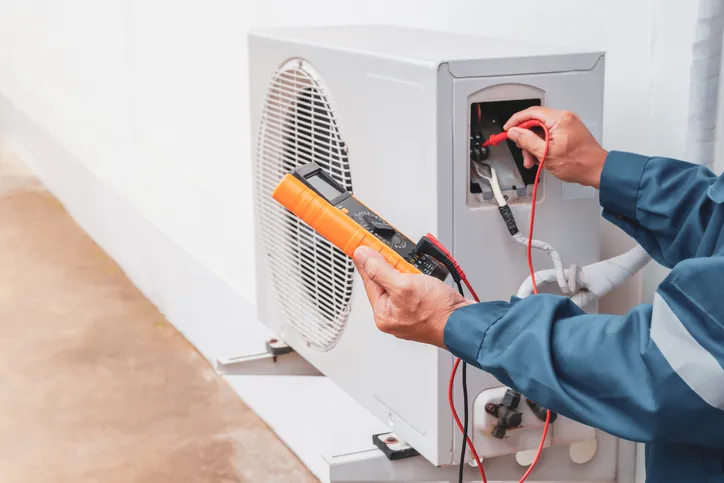HVAC Maintenance in San Jose, CA
Keep your system running smoothly with HVAC Maintenance in San Jose, CA from Precision Heating & Cooling. Schedule your professional tune-up service today!

.avif)
Essential HVAC Maintenance in San Jose, CA: Keeping Your Home Comfortable Year-Round
In the dynamic climate of San Jose, CA, where temperatures can swing from warm summers to chilly winters, your home's HVAC system works tirelessly to maintain a comfortable indoor environment. Just like any complex machinery, an HVAC system requires regular, professional attention to operate at its peak efficiency and reliability. Neglecting this crucial upkeep can lead to higher energy bills, frequent breakdowns, and even premature system failure. At Precision Heating & Cooling, we understand the critical role your heating and cooling system plays in your home, which is why we offer comprehensive HVAC maintenance services tailored specifically for the San Jose community.
Regular HVAC maintenance isn't just about fixing problems; it's about preventing them. It’s a proactive approach to safeguard your investment, ensure consistent performance, and extend the lifespan of your unit. Our skilled technicians are dedicated to providing thorough inspections and tune-ups that address every component of your system, ensuring it's ready to handle the demands of any season in San Jose.
Why HVAC Maintenance is Not Just an Option, But a Necessity
Many homeowners often overlook HVAC maintenance until an issue arises. However, routine service offers a multitude of benefits that directly impact your comfort, finances, and even health:
- Enhanced Energy Efficiency: A well-maintained HVAC system consumes less energy. Over time, dust, dirt, and wear can reduce efficiency, forcing your system to work harder to achieve desired temperatures. Regular cleaning and calibration by Precision Heating & Cooling can restore efficiency, leading to significant savings on your monthly energy bills.
- Extended System Lifespan: Your HVAC system is a substantial investment. Skipping annual maintenance accelerates wear and tear, shortening its operational life. Professional tune-ups can identify minor issues before they escalate into major, costly repairs, ultimately prolonging the life of your equipment.
- Improved Indoor Air Quality: Your HVAC system plays a vital role in circulating air throughout your home. Without proper maintenance, filters become clogged, and coils accumulate dirt and mold, potentially circulating allergens, dust, and other pollutants. Regular cleaning and filter replacement are essential for maintaining healthy indoor air quality for your family.
- Fewer Costly Repairs: Preventative maintenance allows technicians to spot potential problems early on. A small, inexpensive adjustment found during a routine check can prevent a complete system breakdown that would require an emergency service call and more extensive repairs.
- Consistent Comfort: A system that is regularly serviced runs more smoothly and reliably. This means fewer unexpected outages during extreme weather, ensuring your home remains consistently comfortable no matter the conditions outside.
- Preservation of Warranty: Most HVAC manufacturers require proof of annual professional maintenance to keep your warranty valid. Skipping these essential services could void your warranty, leaving you responsible for the full cost of future repairs.

The Precision Heating & Cooling Approach to Comprehensive HVAC Maintenance
Our HVAC maintenance service is meticulously designed to cover all crucial aspects of your system's health. When our expert technicians visit your San Jose home, they perform a multi-point inspection and tune-up that includes:
- Thorough Filter Replacement or Cleaning: Clogged air filters restrict airflow, reduce efficiency, and compromise indoor air quality. We replace dirty filters with new, high-quality ones or thoroughly clean reusable filters.
- Evaporator and Condenser Coil Cleaning: These coils are essential for heat exchange. Over time, they can accumulate dirt and debris, hindering their ability to absorb or release heat effectively. Our team cleans these coils to restore optimal performance.
- Checking Refrigerant Levels: The correct refrigerant charge is critical for cooling efficiency. Too much or too little refrigerant can stress the compressor and reduce cooling capacity. We check and, if necessary, adjust refrigerant levels, and inspect for any leaks.
- Comprehensive System Inspection and Diagnostics: Our technicians perform a detailed examination of all major components, including electrical connections, fan motors, blower components, thermostat calibration, and condensate drains. We look for any signs of wear, corrosion, or potential malfunctions.
- Lubrication of Moving Parts: Proper lubrication reduces friction and wear on moving components, enhancing efficiency and extending the life of motors and bearings.
- Inspection of Belts and Pulleys: We check for signs of wear and proper tension, making adjustments or recommendations for replacement as needed.
- Operational Check of Safety Controls: We verify that all safety features are functioning correctly, ensuring your system operates safely.
- Assessment of Ductwork: While not a full duct cleaning, we visually inspect accessible ductwork for any obvious leaks or damage that could be impacting efficiency.
Our goal is to ensure every part of your HVAC system is operating as it should, preventing future issues and maximizing its performance and longevity for San Jose homeowners.
The Precision Heating & Cooling Advantage
Extend the life of your system with routine HVAC Maintenance in San Jose, CA from Precision Heating & Cooling. Our tune-ups enhance efficiency, lower energy bills, and prevent unexpected repairs. Sign up for our convenient Maintenance Plan for priority service and regular inspections. Curious about our story and values? Visit About Us to see why homeowners trust our team. Protect your comfort investment—schedule your maintenance today with Precision Heating & Cooling, San Jose’s most reliable HVAC experts!
Explore More Services














.avif)





